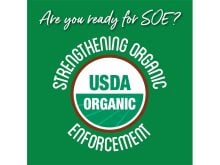Tall, leafy barley varieties that are seeded shallow and grow densely
can eliminate or reduce the need for herbicide, said an Alberta
Agriculture crop specialist.
“It’s a good practice that is going to reduce the reliance on
spraying,” said Ron Hockridge of Wetaskiwin.
Recent trials at the research centre in Lacombe, Alta., showed forage
barley looks promising as a bioherbicide, said Hockridge.
In the trials, tall barley types with wide leaves competed with the
weeds better than the shorter-strawed varieties of barley.
Read Also

U.S. bill could keep out Canadian truckers
The Protecting America’s Roads Act, which was tabled in the U.S. House of Representatives at the beginning of October, would “rid the country of illegal immigrant commercial truck drivers and ineligible foreign nationals.”
During the trials, short and tall barley was seeded at 20 to 24 plants
per sq. foot and at a range of depths from 2.5 to five centimetres with
varying herbicide rates. The tall varieties that were seeded at good
rates to a shallow depth with no herbicide had just as good weed
control as short barley that had been seeded deep and sprayed with the
recommended rates of herbicides.
“The better-competing barleys didn’t have weeds in it.”
Hockridge said new forage barley varieties with more foliage under
development would compete even better with weeds than existing barley
varieties.
Forage barley as a bioherbicide is also being investigated at the
Agriculture Canada research centre in Brandon.
“Forage barley used as a bioherbicide must be harvested as forage,
because of the timing required,” Mario Therrien, a barley breeder at
the centre, said in a News release
news. “This suits a lot of situations.
Many producers have mixed operations or have neighbours with cattle
that can use the forage.”
Barley cut for silage at the soft dough stage and before the weeds have
a chance to set seed also significantly lowered weed populations in
subsequent years.
In addition to lowering herbicide use, using barley as a bioherbicide
can also cut input costs, said Hockridge.
“Overall, the agriculture industry is getting more sensitive to
environmental issues – and their pocket book.”
Forage barley works best as a bioherbicide when the next crop in the
rotation is not a cereal.
“For example, we have found that if you have a weedy field, it’s best
to plant barley in the first year. In the second year, plant canola,
and use proper control methods for the grass weeds. In the third year,
a farmer should be able to grow herbicide-free wheat,” said Therrien.
“We want to look at the best practices for growing the forage barley as
fast possible in a cost-effective manner, to ensure the best
weed-killing action for the buck.”
Once researchers nail down the traits that make some barley varieties
potent weed eradicators, Therrien plans to select for those traits in
his breeding program.
“In the future, we could see a barley variety registered specifically
as bioherbicide.”
















